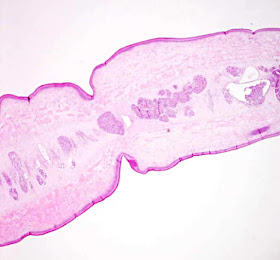This week's case was donated by Dr. Daniel Cohen. The following specimen was submitted to surgical pathology for examination. No additional history was available.
Like all specimens in surgical pathology, it was sectioned and made into H&E-stained slides.
Identification? What structures are we seeing here?




Taenia spp.
ReplyDeleteTaenia spp.
ReplyDeleteThe appearance is that of Taenia proglottids. In the third picture I believe we can see a genital pore as well as the very "young" formation of an ovary and testes.
ReplyDeleteThat's my guess.
Florida Fan
I am going to have to go with Taenia too. This is a perfect example of why proglottids should be examined intact before slicing-and-dicing. As much as I love identifying worms based on their anatomy in histopath, many cestodes essentially look the same cut-up, especially in the absence of eggs (as seen here).
ReplyDeleteThe gross image appears to show proglottids of varying maturity that to me look more like Taenia than one of the diphyllobothriid cestodes. The histopath however reveals a central concentration of reproductive structures (which could have more to do with the angle of the cut than how the animal is laid out.
If this was a diphyllobothriid cestode, I would also expect more evidence of vitelline glands in the lateral portions of the proglottid. Also, I am not sure there is a genital pore evident in the last image; I think the rounds object at the bottom is an ovary or maybe a gland. Most of the internal structure we are seeing here is uterus, but I cannot make out mature eggs.
EDIT: I do not think those are genital pores in the third image, either; I think they are demarcations where the proglottids meet. HOWEVER, I think I see a lateral genial pore in one of the gross proglottids (bottom row, far left), but it could be an illusion created by the texture of the background...
ReplyDeleteBased purely on the image of the specimen (as I have no idea how to interpret histological sections!), I would identify this as Macracanthorhynchus hirudinaceus. There appears to be pseudosegmentation of the adult worm.
ReplyDeleteNow having read everyone else's submissions of Taenia, I'm a bit disappointed that I've probably got this wrong! :-(
DeleteTotal leap faith.
ReplyDeleteI believe I see calcareous corpuscles.
I believe the organs are primordial
I believe the seperations are pseudosegmentations
I believe a surgeon would not waste and H&E submission on just any old thing, unless she/he surgically
removed it from a patient.
My guess is a Sparganum, a perocercoid of Spirometra (Due to its large size) taken from body tissue
Old One,
ReplyDeleteLesson learned! Taking your identification, I went back and did some more web fishing for information. I would agree with Blaine that the seemingly genital pores may just be a pseudosegmentation. In the third picture we can see a seminal vesicle,a cerus sac and a large uterus. On enlarging the picture, there appear to be a few ovoid ova and this will exclude Toenia as a diagnosis.
Thank you for your help.
Florida Fan
This comment has been removed by the author.
ReplyDeleteI am still guessing this is an immature Taenia sp.
ReplyDelete